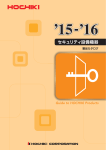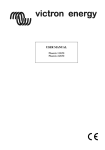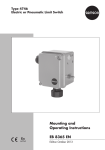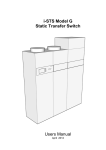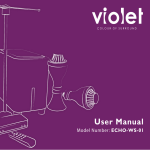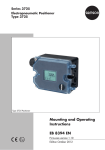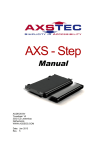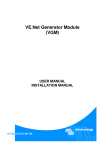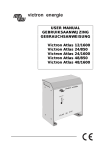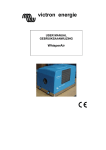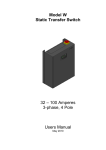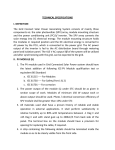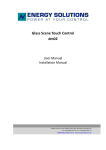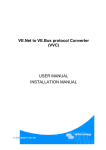Download victr on ener gy
Transcript
victron energy B L U E P O W E R Bus-based power distribution system Installation & Operation manual VE.NET DC victron energy B L U E P O W E R Copyrights © 2006 Victron Energy B.V. All Rights Reserved This publication or parts thereof, may not be reproduced in any form, by any method, for anypurpose. For conditions of use and permission to use this manual for publication in other than the English language, contact Victron Energy B.V. VICTRON ENERGY B.V. MAKES NO WARRANTY, EITHER EXPESSED OR IMPLIED, INCLUDING BUT NOT LIMITED TO ANY IMPLIED WARRANTIES OF MERCHANTABILITY OR FITNESS FOR A PARTICULAR PURPOSE, REGARDING THESE VICTRON ENERGY PRODUCTS AND MAKES SUCH VICTRON ENERGY PRODUCTS AVAILABLE SOLELY ON AN “AS IS” BASIS. IN NO EVENT SHALL VICTRON ENERGY B.V. BE LIABLE TO ANYONE FOR SPECIAL, COLLATERAL, INCIDENTAL, OR CONSEQUENTIAL DAMAGES IN CONNECTION WITH OR ARISING OUT OF PURCHASE OR USE OF THESE VICTRON ENERGY PRODUCTS. THE SOLE AND EXCLUSIVE LIABILITY TO VICTRON ENERGY B.V., REGARDLESS OF THE FORM OF ACTION, SHALL NOT EXCEED THE PURCHASE PRICE OF THE VICTRON ENERGY PRODUCTS DESCRIBED HERE IN. Victron Energy B.V. reserves the right to revise and improve its products as it sees fit. This publication describes the state of this product at the time of its publication and may not reflect the product at all times in the future. 2 Installation & operation manual victron energy Installation & operation manual B L U E P O W E R Table of contents 1 2 Introduction .............................................. 4 1.1 General 4 VE.Net DC......................................... 4 Features ............................................ 4 About this manual.............................. 4 1.2 Safety 4 General.............................................. 4 Modifications ..................................... 4 Service and technical support ........... 4 1.3 Overview 5 Overview of components................... 5 Installation................................................ 6 2.1 Install the system............................... 6 Precautions ....................................... 6 Calculate the needed power.............. 7 Select the nodes................................ 8 Routing from the appliance(s) to the node .................................................. 9 Routing of the bus cable and main fuse box........................................... 10 Install the main fuse box.................. 11 Connect to the battery ..................... 12 Connect the direct power nodes (DPN) .............................................. 13 Install the switch panel .................... 14 Install the node ................................ 16 2.2 Configure the system.......................19 Priority .............................................19 Switch mode ....................................19 Navigation lights ..............................19 Bilge-pump ......................................19 Feedback defective lamp/cable .......19 Reconfigure .....................................19 Store the configuration ....................19 2.3 Start the system the first time ..........20 Configure one switch to one node ...21 Configure one switch to more than one node..........................................21 Configure more than one switch to one node..........................................22 Change priority ................................22 Change feedback of defective lamp/wire .........................................23 Delete connection between switch and node..........................................24 3 4 5 Operation .............................................. 25 Push button panel overview............ 25 Switch on the system ...................... 26 Background light ............................. 26 Warning lights ................................. 27 Indications of the appliances .......... 27 Detection of doors and hatches ...... 28 Direct Power Node (DPN)............... 29 Switch off the system ...................... 30 Maintenance.......................................... 31 4.1 Troubleshooting .............................. 31 4.2 Replace the node............................ 32 If no new nodes are available: ........ 32 4.3 Technical specifications .................. 33 4.4 Spare parts 34 Appendix ............................................... 36 Configuration table (3x)................... 36 3 victron energy B L U E Installation & operation manual P O W E R 1 Introduction 1.1 General VE.Net DC Features About this manual Congratulations on purchasing a VE.Net DC bus power distribution system for your vessel. The system is delivered as a set and can be assembled according to CE standard. It is essential therefore to follow the installation instructions carefully. VE.Net DC is a modern electronically controlled bus system. Special built in features reduce the risk of a cable fire or a low-voltage situation. Built in features include: • An electronic fuse for each load. The fuse can be reset with the switch push button. • All warnings are both visual and audible. • A warning for broken (navigation) light or wire. • A warning for overloads. The appliance turns off automatically. • A warning for low voltage. The appliance turns off automatically. • An adjustable background light in the switch panel. This user manual describes the installation and operation of the VE.Net DC system. Read this manual carefully before use or operation of the product. In case you have any doubt about a procedure contact your dealer. 1.2 Safety General Modifications Observe all safety instructions. Use this product only for the purpose it is intended for. Please contact your dealer immediately if a potential danger arises during the use of this product. Modifications to the product are not permitted. Service and technical support For information concerning specific settings, maintenance or repair work, contact your local dealer. 4 victron energy Installation & operation manual 1.3 B L U E P O W E R Overview Overview of components A. Cable harness including: • 10 A fuse • 50 A fuse • 10 A. direct power node • 20 A. direct power node • 2 × 15 m. bus cable • 8 m cable for push button panel • 8 m cable for bilge-pump • 8 m cable for instruments B. Push button panel C. 3 A. power nodes D. 10 A. power nodes E. 16 A. power nodes F. Sensor node for bilge-pump G. Cable cutter H. DC 4 compound (tube) I. CD labels C(5x) 3 D(8x) 10 F(1x) S A(1x) G(1x) H(1x) B(1x) E(2x) 16 I(1x) 5 victron energy B L U E Installation & operation manual P O W E R 2 Installation 2.1 Install the system Precautions Observe the following when you wire the system: 1. Never install any components above batteries or fuel tanks. 2. Never install components or cables near heat sources that may melt the insulation. 3. Never expose components or cables to oil or grease. 4. Never install components when there is a risk of exposure to water. 5. Never use twist-on connectors. 6 • • • • • Always use insulation barriers to prevent a short circuit of exposed terminal connectors. Always use the correct tool. Always take the necessary precautions to protect the components and cables from damage. Always clamp the wires at least every 30 cm (12”). Protect cables that pass bulkheads or structural members against damage by grummets or equivalent means. • • • • • Protect components and wires with sheets, conduits or equivalent means when there is a risk of physical damage. All wires must be fire resistant, finestranded and tinned. Always use the correct cable diameter and colour. This is indicated on the node. Wires outside the motor compartment must be rated at minimum 60 °C / 140 °F. Wires inside the motor compartment must be rated at minimum 70 °C / 158 °F. Installation & operation manual victron energy B L U E P O W E R Calculate the needed power Calculate the total power and the amount of nodes for each bus-cable before you start installation. 1. Calculate for each single appliance or groups of appliances the power needed. • 1 A per 10 W for a 12 V system • 0,5 A per 10 W for a 24 V system 2. Divide the appliances as evenly as possible between the two bus cables. Each bus cable can have a maximum load of 50 A. 3. Select the node with the correct amperage. Refer to Select the nodes. 4. Write down the configuration of the nodes in the Configuration tables. Refer to the Error! Not a valid bookmark self-reference.. Warning! Do not install nodes in a petrol engine compartment or a gas locker. There is a risk of ignition and explosion. Note: Appliances connected to the Direct Power Nodes do not influence the total power on a bus cable. 7 victron energy B L U E Installation & operation manual P O W E R Select the nodes We recommend the following set-up: Node Appliance Cable Diameter 2 (mm ) (AWG) 3A Navigation light Interior light Deck light Instruments Interior light Power outlet Refrigerator Fresh water pump Bilge-pump Automatic switch bilge-pump 1,5 16 1,5 16 2,5 14 1,5 16 10 A 16 A Sensor node on/off Note: Connect the delivered sensor node to the automatic switch of the bilgepump. 8 Caution! The node triggers when there is more power applied than specified. Caution! Connect the radar, compass GPS and bilge-pump to a direct power node. The direct power nodes are located in the main fuse box. victron energy Installation & operation manual B L U E P O W E R Routing from the appliance(s) to the node Node 1. Lay-out the wires from the appliance to where the node will be placed. 2. Cut the wires to the correct length. Allow extra length to tighten up the cables with tie-wraps. Refer to the drawing. 3. Attach the connectors on the end of the wires. 4. Lay-out single appliances directly to the node. Node 5. Lay-out group appliances parallel to the node. 9 victron energy B L U E Installation & operation manual P O W E R Routing of the bus cable and main fuse box max. 200 cm 80" 1. Lay-out the bus-, instrument-, switchboard- and bilge-pump cables and the main fuse box to where they will be placed. Note: Make sure the main fuse box is easy to access. 10 Warning! Do not install nodes in a petrol engine compartment or a gas locker. There is a risk of ignition and explosion. Note: Make sure that the cable between the fuse box and the battery has a maximum length of 200 cm (80”). Warning! If the +cable (red) between the main fuse box and the battery is longer than 200 cm (80”), it needs a fuse of 80 A at the battery. victron energy Installation & operation manual B L U E P O W E R Install the main fuse box 1. Remove the cover of the main fuse box. Note: Make sure the main fuse box is easy to access. 2. Install the main fuse box on a suitable surface. 3. Set the fuses in the OFF position. 4. Replace the front cover. Warning! Make sure all fuses are set in the OFF position. 11 victron energy B L U E Installation & operation manual P O W E R Connect to the battery 20 mm 6/8" 15 mm 5/8" 1. If necessary, adjust the length of the bus wires at the main fuse box. 2. Remove the cover of the main fuse box. 3. Loosen the screw to remove the wire on the fuse. 4. Cut the wire. 5. Remove 15 mm (5/8“) of the insulation at the end of the wire. Use the cable cutter to cut the insulation. 6. Place the wire back on its place. 7. Tighten the screw to secure the wire. Note: Do the procedure for one wire at a time. Warning! Follow the instructions properly to reduce the risk of future shortcut with possible fire. 12 8. Clamp the bundles of + (red) and – (black) battery wires with at least 20 mm (6/8") distance in between. 9. Connect the red cable to the + terminal on the battery. 10. Connect the black cable to the terminal on the battery. Warning! Make sure there is no risk of physical damage for the cables. In case there is a risk, protect the cables with grummets or equivalent. victron energy Installation & operation manual B L U E P O W E R Connect the direct power nodes (DPN) 12 11 12 11 30 cm 12" Fusebox Max 10 A DPN 1. Start from the main fuse box. 2. Clamp the 10 A Direct Power Node (DPN) wires to the instruments. If necessary, install a multiple fuse box with a total of 10 A between the different instruments and the node. Refer to the illustration. 3. Clamp the 20 A DPN wires to the bilge-pump. Note: Do not connect the wires to the appliances mentioned. 4. Attach the wires for the push button panel. Leave 30 – 40 cm (12 – 16“) extra length for easy connection of the switch panel. 5. Attach the wires with a clamp every 30 cm (12“). Note: Clamp the wires of the instruments, bilge-pump and switch board separated from the bus cable. Caution! The instruments and VHF may need a separate fuse. Refer to the instrument user manual. 13 victron energy B L U E Installation & operation manual P O W E R Install the switch panel O 20 mm 6/8" 1. Remove the cover of the switch panel. Note: • Handle the cover with the electronics with care. • Do not touch the electronics. • Place the cover with the electronics in the box during installation. 14 2. Feed the wires through a 20 mm (6/8“) hole. 3. Feed the wires through the back panel. 3. Install the back panel on a suitable surface. victron energy Installation & operation manual B L U E P O W E R Bus GND VBAT Violet Black Red 4. Insert the labels in the cover. Note: • Switch 1 and 4 are reserved for the bilge-pump. • If necessary, make new labels with the delivered CD. • Use an overhead sheet to print the labels. 5. Connect the wires to the electronics. 6. Replace the front cover. 15 victron energy B L U E Installation & operation manual P O W E R Install the node 2 mm 1/16" Note: Start with the node closed to the main fuse box. 1. Install the node base onto a suitable surface. Note: • Align the side of the node marked with + with the red bus cable • Align the side of the node marked with – with the black bus cable. 16 2. Push the wires into the base. 3. Mark the places of the clips on the wires. Warning! Do not use the node base and the clips more than one time. Mounting deforms the clips and base. 4. Cut the insulation with the cable cutter. 5. Bend the wire several times until 2 mm (1/10”) of the conductors are exposed. victron energy Installation & operation manual 6. Push the clips onto the wire. Make sure the clips make contact with the exposed wires. 7. Put some DC4 compound around the clips. B L U E 8. Push the clips into place to secure. 9. Repeat these steps for the other wire. P O W E R 10. Put some DC4 compound around the violet wire. Put the compound on the place of the single clip. 11. Push the wire into its position. 12. Use a hammer to secure the clip in the base. 17 victron energy B L U E Installation & operation manual P O W E R 30 cm 12" 13. Place the middle cover 14. Attach the proper node. 15. Attach the connectors to the wires and clamp them accordingly. Caution! Do not connect the wires to the node. This will be done during the configuration of the system. 18 16. Attach the wires with a clamp every 30 cm (12”). Allow some space for additional nodes to install. 17. On the end of the bus cable: Cut the bus cables to the proper length and insulate them with insulating tape. victron energy Installation & operation manual 2.2 B L U E P O W E R Configure the system Priority Switch mode Navigation lights The node priority is used when there is an overload or low voltage situation. The nodes with a low priority turn off first to make sure important systems remain in operation. Therefore it is important to set the priority of each node correctly. The priority is automatically set in the order of configuring the nodes. The first configured nodes are set to the highest priority. The switch buttons can be set to two different switch modes: • Toggle mode: When the switch is pushed, the appliance functions until the switch is pushed again. Use this mode for the refrigerator, lights etc. • Direct mode: The appliance functions as long as the switch is pushed. Use this mode for the horn, winch etc. There are three options: 1. Configure each lamp to a separate node, but to the same switch. The switch indicates malfunction, but not which light is defective. 2. Configure each lamp to a separate switch and a separate node. The indication shows which light is defective. 3. Configure each lamp to a separate node, but to the same switch. Combined with a VE.Net DC Navigation light board it is easy to see which light is defective. Bilge-pump Feedback defective lamp/cable Reconfigure The bilge-pump and its sensor node do not need to be configured. They are set in the factory on switch 1 (automatic) and switch 4 (manual) with the highest priority. It is enough to connect the Direct Power Node (DPN) wires to the pump and the automatic switch to the sensor node. The system indicates whether a lamp/wire is defective or when a motor is not running. It is possible to configure the appliance not to include this indication. This is recommended for appliances such as 12 V outlet, refrigerator, automatic pumps etc. 1. Disconnect the appliance from the node. 2. Follow the procedure as for normal configuration. Caution! The reconfigured appliance is set to the lowest priority. Store the configuration It is necessary to store each configuration separately. To do this, turn the push button panel off and on after you finished the specific configuration. 19 victron energy B L U E 2.3 Installation & operation manual P O W E R Start the system the first time 1. Switch on all main fuses. 2. Switch on the push button panel. Warning: In case of immediate alarm (buzzer and lightening of the polarity warning led): 1. Turn of the system through the main fuses immediately. 2. Check the polarity at the batteries. Change if necessary. 3. Turn on the system again. See chapter Maintenance. 20 3. Proceed with configuration. victron energy Installation & operation manual B L U E P O W E R Configure one switch to one node Toggle C2 2 sec C1 Direct 5 sec 1. Push the + and – for two seconds. The display shows C1. 2. Connect the appliance to the node. The display shows C2. The buzzer gives a signal. C3 3. Push the desired push button. • Push shortly to select toggle mode. The display turns off and the buzzer stops. • Push for 5 seconds to select direct mode. The display shows C3 and the buzzer stops. Configure one switch to more than one node Use the above procedure. Repeat the procedure for each node that you want to connect to the switch. 21 victron energy B L U E Installation & operation manual P O W E R Configure more than one switch to one node 2 sec C1 1. Do the procedure as in ´Configure one switch to one node´. 2. Push the + and – for two seconds. The display shows C1. 1 C4 3. Push the first configured switch button shortly. # 4. Push the desired switch shortly. The switch is configured automatically to the same mode as the first switch. The display turns off. Change priority P0 2 sec C1 1. Push the + and – for two seconds. The display shows C1. 22 x2 P1 2. Push the + 2 times shortly. The display shows P0. 3. Push the – to set the priority. The display shows P1, P2 or P3. P1 is high priority. # 4. Push the switch button that corresponds to the node. The display turns off. Caution! Do not set all appliances to the same priority. victron energy Installation & operation manual B L U E P O W E R Change feedback of defective lamp/wire Fb 2 sec C1 1. Push the + and – for two seconds. The display shows C1. 3x F1 F0 2. Push the + 3 times shortly. The display shows Fb (Feedback). 3. Push the – to set the feedback: • F1: Feedback on; • F0: Feedback off (recommended for refrigerator, automatic running motor, and groups of separately switched appliances. # 4. Push the switch button that corresponds with the node. The display turns off. Note: Be aware that an automatic motor and appliances with separate conventional switches, when not activated, will indicate “defective lamp/wire”. 23 victron energy B L U E Installation & operation manual P O W E R Delete connection between switch and node rS 2 sec C1 4x # 1. Push the + and – for two seconds. The display shows C1. 24 2. Push the + 4 times shortly. The display shows rS (Reset). 3. Push switch to delete shortly: The switch illuminates green and the appliance switches on. 4. Turn off and on the push button panel to store the deleted function. The green light and the appliance turn off. The connection between the switch and the node is deleted. victron energy Installation & operation manual B L U E P O W E R 3 Operation Push button panel overview A. B. C. D. E. F. G. On/off Push button Label Warning light ´Over current´ Warning light ´Polarity´ Display - Button (background light / configuration) H. + Button (background light / configuration) C D over current E G polarity C3 A B F H 1 2 3 4 5 6 7 8 9 10 11 12 13 14 15 16 17 18 19 20 21 25 victron energy B L U E Installation & operation manual P O W E R Switch on the system # 1. Switch on all fuses. 2. Push the ON/OFF button. The indication lights in the ON/OFF switch and the + and – buttons turn on (green). The switch panel is ready for use. 3. Push the switch button of the node to turn on the corresponding appliance. A green light in the switch button indicates that the corresponding node is turned on. 1. Push + to increase the level of the background light. The maximum level is 6. A beep signals that this level is reached. 2. Push – to decrease the level of the background light. The minimum level is 1. A beep signals that this level is reached. Background light When the switch panel is turned on, the background light is illuminated in the medium level (level 4). 26 victron energy Installation & operation manual B L U E P O W E R Warning lights The two warning light on the push-button panel warn you for the following failures: • Wrong polarity • Overload of the system / low voltage Light Polarity Buzzer Continuous Meaning Battery connected wrong, the + and – connectors have been mismatched Overload Interrupted The system is overloaded or the battery voltage is too low (battery is discharged). Light Green Buzzer No Blinking green Yes Blinking green / red Blinking red Yes Meaning Appliance is turned on and functions normally. No appliance. Light defective or wire between node and appliance defective. Circuit is nearly overloaded or node is nearly overheated. Circuit is overloaded or overheated and turned off automatically Action Turn off all fuses in the fuse box. Check the polarity of battery and change it correctly. Devices may be overheated and damaged if the polarity was wrong for over a minute. Turn off appliances that are not absolutely necessary. If the situation continues, the system switches off appliances automatically in order of priority. Indications of the appliances Each appliance is automatically tested during its operation. In that case, the light in the switch button is green. Other indications in the push-buttons are explained in the table. In case of a failure, turn off the appliance with the push-button. The buzzer, indication led and automatic fuse are reset. Repair the appliance. Switch on the appliance to test. Yes Action Check lights or wires. Press the – button to reset the buzzer. Turn off the node. Push the switch button to reset. Check the wires from the node to the appliance for short circuits. 27 victron energy B L U E Installation & operation manual P O W E R Detection of doors and hatches The buttons on the switch panel can be used for detection if a door or a hatch is opened. For this purpose, a special sensor node is necessary. 28 Light Meaning Red Door / hatch / switch closed Door / hatch / switch open victron energy Installation & operation manual B L U E P O W E R Direct Power Node (DPN) l ita Dig er w po on t ec Dir er w po on r we po f of Appliances that are connected to a direct power node are normally switched on by the switch board. l ita Dig er w po on t ec Dir er w po on r we po f of In case of malfunction of the switch board: 1. Push the bypass fuse on the direct power node to switch on the appliance. l ita Dig er w po on t ec Dir er w po on r we po f of In case the appliance cannot be turned off with the switch board: 2. Release the power fuse of the direct power node. 29 victron energy B L U E Installation & operation manual P O W E R Switch off the system over current 1 polarity 2 1. Push the ON/OFF switch. The indication lights and appliances turn off. Note: In case the bilge-pump operates while you turn off the system, it stays in operation. 30 Warning! Always Turn off all fuses in the main fuse box before you start working on the electrical system! Note: In case it is preferred to leave some appliances (e.g. refrigerator, alarm installation) in operation, it is necessary to leave the system on. To minimize the power consumption of the system, decrease the background light. Refer to Background light victron energy Installation & operation manual B L U E P O W E R 4 Maintenance 4.1 Troubleshooting Problem Polarity light is illuminated, a continuous beep is heard. Possible cause • Battery is connected wrong. No action when the ON/OFF button is pushed. • • After a button is pushed, no warnings and no power at the appliance. • • Overload light is illuminated, a interrupted beep is heard. • • Switch blinks red, a beep is heard. • Switch blinks green, a beep is heard. • • Bilge-pump or instruments connected via a direct power node cannot be turned off. • • The 10 A fuse in the main fuse box is released. Push button panel is connected wrong. The 50 A fuse in the main fuse box is released. Bus cable and node are connected wrong. The voltage is low. The circuit is overloaded. Short circuit between node and appliance. Wire between node and appliance is defective. Light is defective. The bypass fuse of the direct power node is switched on. DPN is defective. Possible solution • Turn off the main power immediately. • Check the polarity of the battery connection. • Check the voilet bus wire. • Reset the fuse • Check the connections of the switch panel. Reconnect if necessary. • Check the red plus wire. • Reset the fuse. • Check the connections between bus cable an the node. Reconnect if necessary. • Turn off appliances. If not, the system turns off appliances automatically by order of priority. • Check the wires between the appliance and node. • In case of a built-in safety device in the appliance: turn off the warning. Refer to Feedback defective lamp/cable. • Replace the lamp of the light. • Turn off the bypass fuse of the DPN. • Turn off the power of the DPN. 31 victron energy B L U E 4.2 Installation & operation manual P O W E R Replace the node Red/Violet 1. Switch off all fuses. 2. Unplug the connectors on the node. Make sure which connector is connected to + and –. 3. Push a screwdriver into the node for approximately 5 mm. 4. Turn the screwdriver; you may need to apply some force because of possible corrosion. 5. Push in the new node. Note: Make sure to replace the node with a new one of the same type. 6. Configure the node. Refer to Configure the system. 32 If no new nodes are available: Warning! Use this procedure only in case of an emergency and when no spare parts are available. Warning! Make sure the + and – cables cannot make contact with each other. Possible risk of short circuit! Black For appliances connected via a power node: 1. Disconnect the node. Follow steps 1 to 4 of the procedure on the left. 2. Place a wire between the black cable of the bus and the black cable of the appliance. 3. Take a fuse with the same rating as the corresponding node. 4. Place the fuse with a wire between the red cable of the bus and the red cable of the appliance. victron energy Installation & operation manual 4.3 B L U E P O W E R Technical specifications System voltage Voltage range Standby power consumption Active power consumption Storage temperature Operational temperature Maximum bus cable length Maximum number of nodes Maximum length of bus cables (for boats) Maximum load with 15 m of bus cable Maximum number of bus cables Weight of a 130 A system with 20 nodes Complies to International standards CE approval EMC approvals : : : : : : : : : : : : : : : : 12 V 10-16 V <10 mA Approximately 100 mA -20 ºC to +70 ºC (-4 °F to 158 °F) -4 ºC to +50 ºC (24 °F to 122 °F) 100 m / 328 ft 255 15 m / 50 ft 50 A Indefinite 20 kg / 44 lbs 94/25/EC and 89/336/EEC ISO 10133 Yes EN 61000-6-2 (2001) and EN 61000-6-3 (2001) 33 victron energy B L U E 4.4 Installation & operation manual P O W E R Spare parts 8 5 7 6 9 15m 2 1 3 10 34 4 11 12 13-14-15-16-17-18-19 20 victron energy Installation & operation manual Number 1 2 3 4 5 6 7 8 9 10 11 12 13 14 15 16 17 18 19 20 Article description Main Fuse 10 A Direct power node 10 A Fuse 10 A Main Fuse 50 A Direct power node 20 A Fuse 20 A Cabling bus 50 A (complete) Cable cutter Dielectric gel Frame 21 keys / Navigation light Push-button plate Node base single Power node 16 A Power node 10 A Power node 3 A Branch node Sensor node switch 12 V Sensor node open/close 12 V Sensor node level 12 V Slides node base single B L U E P O W E R Article number MF10A-0 DPN10A-0 DPNF 10A-0 MF50A-0 DPN20A-0 DPNF20A-0 CB50A-0 CC16-0 DC4-0 FPB21NL-0 PBP21K12V-0 NB1-0 PN16A-0 PN10A-0 PN3A-0 BN-0 SNS12V-0 SNOC12V-0 SNL12V-0 SNB1-0 35 victron energy B L U E P O W E R 5 Appendix The following sections can be used and (when necessary) removed from this manual: Configuration table (3x) 36 Installation & operation manual victron energy Installation & operation manual B L U E Configuration table Type node Serial nr. P O W E R Bus cable number: . . . . . . . . . . . . . . . . . Priority Switch nr. Type of appliance Amperage Total amperage for the bus cable 37 victron energy B L U E Installation & operation manual P O W E R Configuration table Type node Serial nr. Bus cable number: . . . . . . . . . . . . . . . . . Priority Switch nr. Type of appliance Total amperage for the bus cable 38 Amperage victron energy Installation & operation manual B L U E Configuration table Type node Serial nr. P O W E R Bus cable number: . . . . . . . . . . . . . . . . . Priority Switch nr. Type of appliance Amperage Total amperage for the bus cable 39 victron energy B L U E P O W E R Victron Energy B.V. De Paal 35 1351 JG ALMERE The Netherlands www.victronenergy.com [email protected]









































